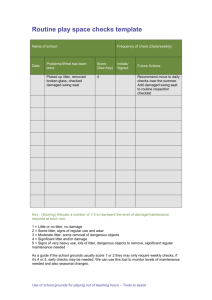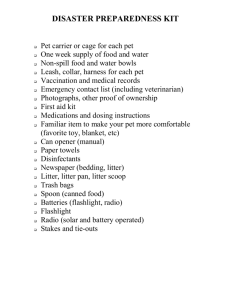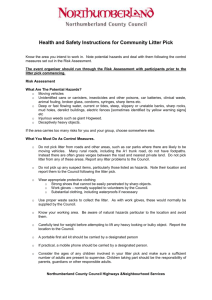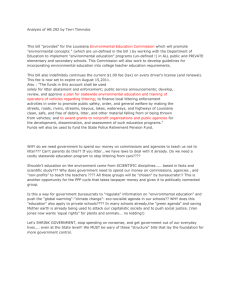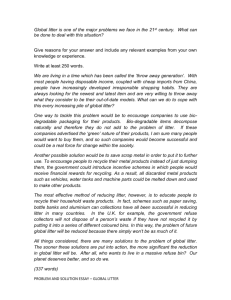Smoke Production, ROS, and Consumption Exercise
advertisement
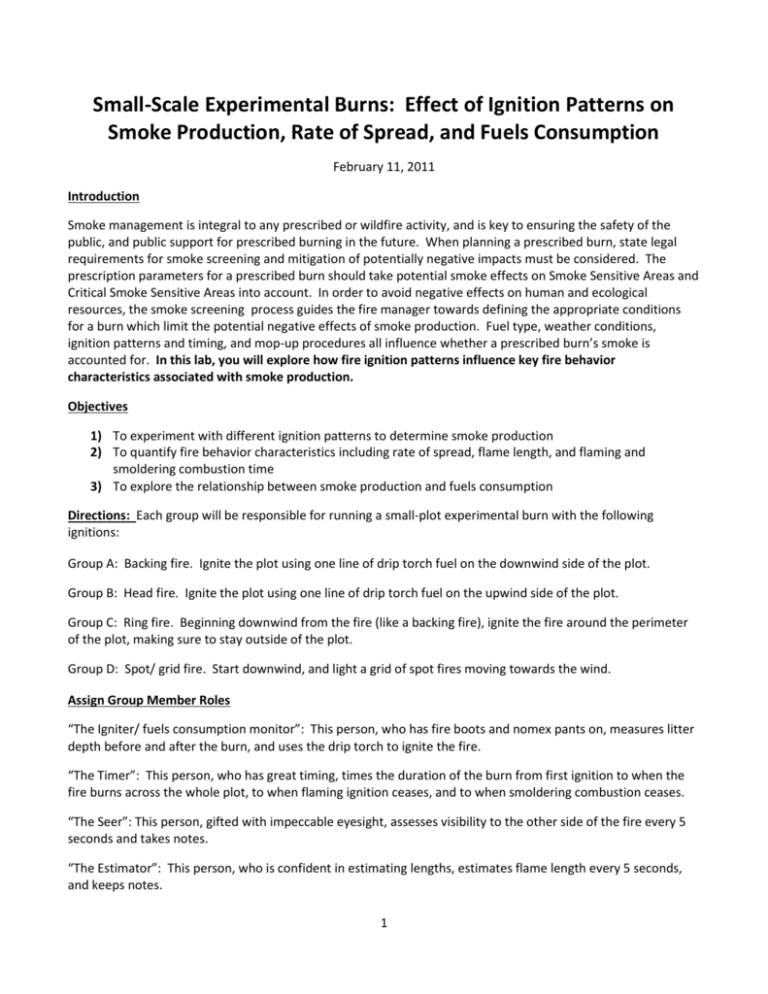
Small-Scale Experimental Burns: Effect of Ignition Patterns on Smoke Production, Rate of Spread, and Fuels Consumption February 11, 2011 Introduction Smoke management is integral to any prescribed or wildfire activity, and is key to ensuring the safety of the public, and public support for prescribed burning in the future. When planning a prescribed burn, state legal requirements for smoke screening and mitigation of potentially negative impacts must be considered. The prescription parameters for a prescribed burn should take potential smoke effects on Smoke Sensitive Areas and Critical Smoke Sensitive Areas into account. In order to avoid negative effects on human and ecological resources, the smoke screening process guides the fire manager towards defining the appropriate conditions for a burn which limit the potential negative effects of smoke production. Fuel type, weather conditions, ignition patterns and timing, and mop-up procedures all influence whether a prescribed burn’s smoke is accounted for. In this lab, you will explore how fire ignition patterns influence key fire behavior characteristics associated with smoke production. Objectives 1) To experiment with different ignition patterns to determine smoke production 2) To quantify fire behavior characteristics including rate of spread, flame length, and flaming and smoldering combustion time 3) To explore the relationship between smoke production and fuels consumption Directions: Each group will be responsible for running a small-plot experimental burn with the following ignitions: Group A: Backing fire. Ignite the plot using one line of drip torch fuel on the downwind side of the plot. Group B: Head fire. Ignite the plot using one line of drip torch fuel on the upwind side of the plot. Group C: Ring fire. Beginning downwind from the fire (like a backing fire), ignite the fire around the perimeter of the plot, making sure to stay outside of the plot. Group D: Spot/ grid fire. Start downwind, and light a grid of spot fires moving towards the wind. Assign Group Member Roles “The Igniter/ fuels consumption monitor”: This person, who has fire boots and nomex pants on, measures litter depth before and after the burn, and uses the drip torch to ignite the fire. “The Timer”: This person, who has great timing, times the duration of the burn from first ignition to when the fire burns across the whole plot, to when flaming ignition ceases, and to when smoldering combustion ceases. “The Seer”: This person, gifted with impeccable eyesight, assesses visibility to the other side of the fire every 5 seconds and takes notes. “The Estimator”: This person, who is confident in estimating lengths, estimates flame length every 5 seconds, and keeps notes. 1 Detailed Instructions for Measurements “The Igniter”: Fuel Consumption In order to determine the proportion of the fuel consumed during the burning of the fuelbeds we will simply estimate the proportion of the litter depth that was consumed. All you will need is pre-burn and postburn litter depth measurements. After fuel is loaded into the burning rings, take four litter depth measurements, one at each cardinal direction and at approximately one-third of the distance from the edge of the ring. Record the litter depths in the pre-burn column below in the row that corresponds to the cardinal direction of the sample measurement. After burning is complete take four additional litter depth measurements at the same locations and record them in the table. Subtract the post-burn measurement from the pre-burn measurement to get litter depth consumed. Now divide this number (litter depth consumed) into the pre-burn litter depth measurement to calculate the proportion of litter consumed. Do this for each of the four sample points and the calculate the average proportion of fuel consumed during burning. Now compare the proportion of fuel consumed across the four burning scenarios. Are there any differences in fuel consumption that may be attributed to the type of ignition and subsequent burning behavior? We can take this one step further to estimate the mass of fuel consumed over a unit area by using the proportion of fuel consumed and an assumed value of pre-burn fuelbed bulk density. We will do this by using just the litter depth consumed and an equation that predicts litter mass per hectare from litter depth by assuming a constant fuelbed bulk density (~23 kg/m3). Use your litter depth consumed values from each of the four sample points and estimate the mass (Mg)of fuel consumed per hectare using the equation provided below. Remember most fancy 'smart' phones, and even the non-smart phones, have a calculator on them. “The Timer” Rate of Spread Record the time when the igniter starts ignitions. Record how long it takes for the fire to move across the entire plot. Next, record how long flaming combustion (flames are visible) continues. Finally, record when all smoking has ceased. “The Seer”: Visibility You have a challenging task. Since we don’t have the ability to measure amounts of particulate matter in the smoke, you will be estimating the only thing we can measure about smoke; visibility. Every five seconds or so, record how many letters you can see clearly across the fire. Be sure to take a mental “snapshot”. Don’t wait for the letters to become clear. Calculate the mean number of letters seen during both flaming and smoldering. “The Estimator”: Flame Length Flame length is measured from the base of the flaming front to the tip of the visible flame. It is NOT the same as flame height. Unless there is no wind, flame length will typically be longer than flame height is high. To estimate flame length, prepare yourself: stand at about 10 feet away from the plot, have someone hold a tape up at 1 m length (or any measure you are familiar with, say, feet), and use your hand to determine how the meter distance can be estimated from where you’re standing. Take measurements at about every 5 seconds and quickly write down the numbers, or have someone record for you. Calculate the mean number. 2 DATA SHEET IGNTION PATTERN: GROUP MEMBERS: DATE: “The Igniter”: Measures Fuel Consumption using a ruler at four litter depth measurement locations, one at each cardinal direction and at approximately one-third of the distance from the edge of the ring. Group works together to calculate litter mass consumption as described above. Sample Pre-Burn Litter Depth(cm) Post-Burn Litter Depth (cm) Litter Depth Consumed (cm) Proportion Consumed North East West South Mean: Pre-Burn Litter Depth-Post-Burn Litter Depth=Litter Depth Consumed Litter Depth Consumed/Pre-Burn Litter Depth = Proportion Consumed Litter Mass Equation 𝐿𝑖𝑡𝑡𝑒𝑟 𝑀𝑎𝑠𝑠 𝐶𝑜𝑛𝑠𝑢𝑚𝑒𝑑 (𝑀𝑔ℎ𝑎−1 ) = 238+199×𝐿𝑖𝑡𝑡𝑒𝑟 𝐷𝑒𝑝𝑡ℎ (𝑐𝑚) 100 “The Timer”: Rate of Spread When to measure Time of Day Length of time (subtract from time of day) Start of burn Whole plot burned Flaming combustion ceases Smoldering combustion ceases (no smoke) 3 Litter Mass Consumption (Mg/ha) “The Seer”: Visibility Flaming Combustion Measurement 1 Number of letters visible Smoldering Combustion Measurement Number of letters visible 1 2 3 4 5 6 7 8 9 Mean 2 3 4 5 6 7 8 9 Mean “The Estimator”: Flame Length/ stop measuring once fire has burned across entire plot. Measurement 1 Flame Length 2 3 4 5 6 7 8 9 Mean Questions 1) How did your ignition pattern compare to others in terms of flame length, visibility, consumption, and rate of spread? 2) What did you expect to see? What could explain differences between your expectations and your observations? 3) What is the best ignition method for reducing smoke production during flaming and smoldering combustion? In what cases would you NOT want to use this method? 4

